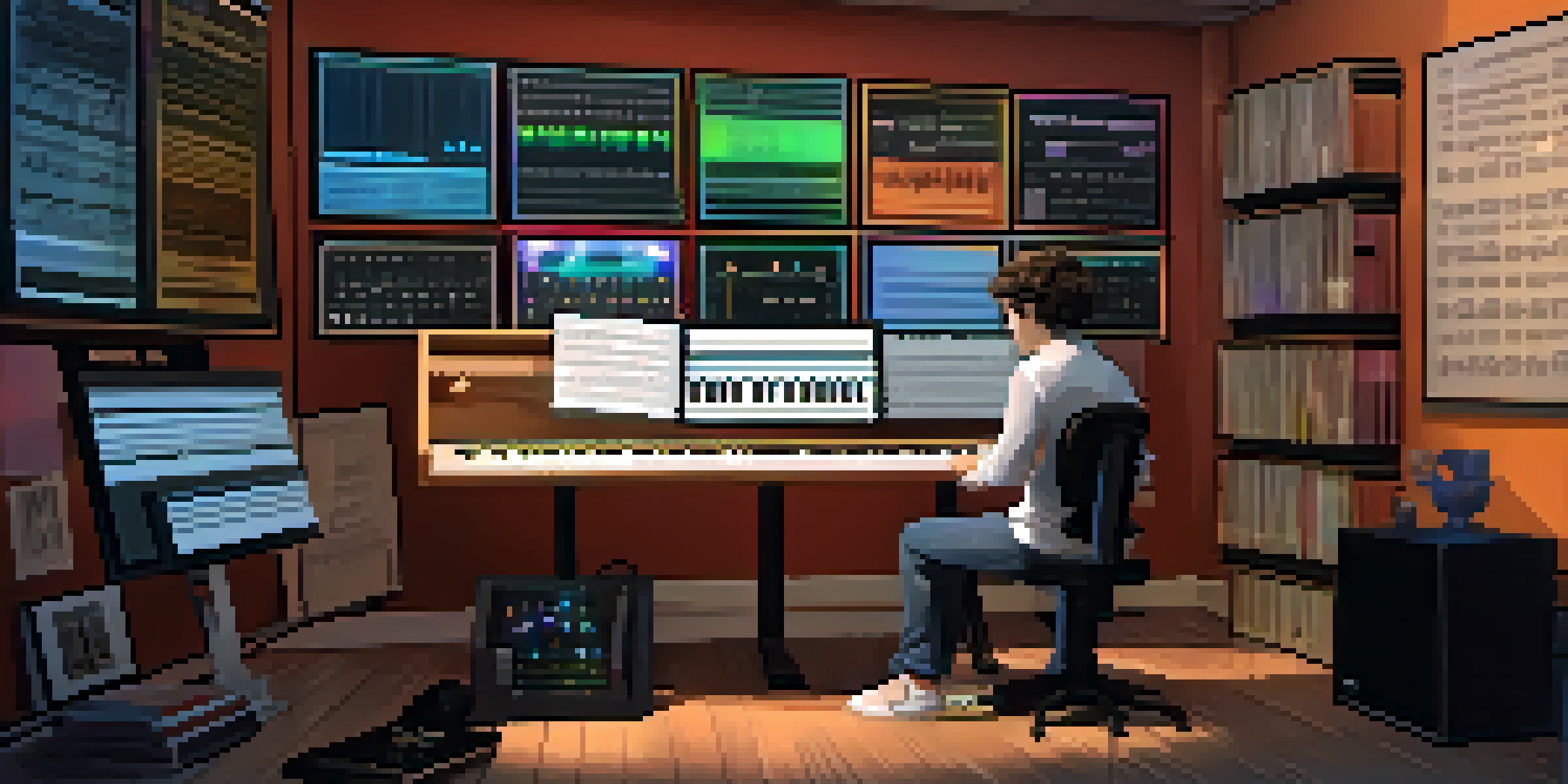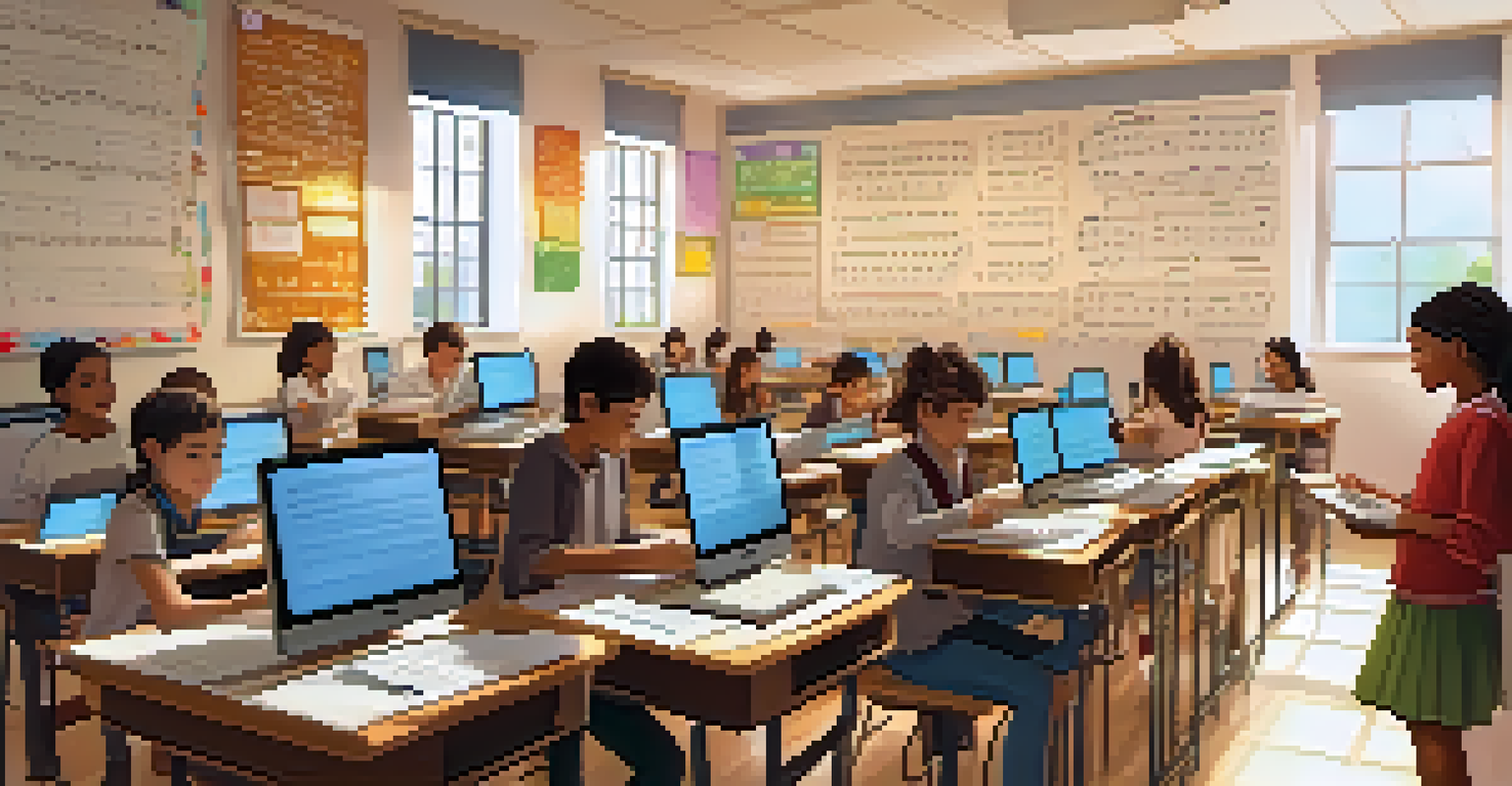Digital Notation Software: Revolutionizing Music Composition

Introduction to Digital Notation Software in Music
Digital notation software has fundamentally changed how musicians compose and share their work. Gone are the days of scribbling notes on paper, as technology has introduced tools that make the process faster and more efficient. This software allows composers to visualize their music in real-time, offering features that enhance creativity and organization.
Music is the shorthand of emotion.
Imagine a young composer, teetering on the edge of inspiration, suddenly able to lay out complex harmonies and rhythms with a few clicks. Digital notation software not only simplifies this process but also provides instant playback, making it easier to hear how compositions sound. This immediacy can spark new ideas and refine existing ones, ultimately leading to polished pieces.
Moreover, with the rise of collaboration in music, digital notation software allows multiple musicians to work on a piece simultaneously, regardless of their physical location. This democratization of music composition is a game-changer, fostering creativity and sharing in ways that were previously unimaginable.
Key Features of Digital Notation Software
One of the standout features of digital notation software is its intuitive interface. Most platforms are designed with user-friendliness in mind, allowing anyone from beginners to seasoned composers to navigate easily. Tools like drag-and-drop functionality for notes and customizable templates streamline the composition process, making it accessible to all levels of musicianship.

Another significant advantage is the ability to create high-quality sheet music. Unlike handwritten scores that may have inconsistencies, digital notation software ensures that every note is perfectly aligned, creating professional-looking results. This quality is especially important for musicians who need to share their compositions for performances or competitions.
Transforming Music Composition
Digital notation software enhances creativity and efficiency, allowing composers to visualize and hear their work instantly.
Additionally, many software options come equipped with built-in libraries of instruments and sounds. This feature enables composers to experiment with different musical textures and arrangements, ultimately enhancing the creative process. Imagine being able to hear how a cello would sound in your piece without needing to hire a musician!
The Role of Playback in Music Composition
Playback functionality is a cornerstone of digital notation software. It allows composers to hear their creations immediately, which can be invaluable for making adjustments and improvements. This feature effectively bridges the gap between the written score and the auditory experience, ensuring that the composer’s vision is realized.
The beautiful thing about music is that it transcends language.
Consider this: a composer writes a complex orchestral piece but struggles to visualize how the different parts interact. With playback, they can instantly hear how the strings blend with the woodwinds, leading to a more cohesive final product. This instant feedback loop fosters a more dynamic and iterative composition process.
Moreover, playback can serve as a learning tool. Musicians looking to improve their skills can use the software to understand how different instruments interact, providing an educational advantage. It’s like having a personal mentor guiding you through the intricacies of arrangement and orchestration.
Collaboration and Sharing in the Digital Age
Digital notation software has made collaboration easier than ever. Musicians can share their compositions with peers instantly, allowing for real-time feedback and contributions, regardless of geographic barriers. This ability to work together enhances creativity and leads to richer musical outcomes.
Picture a group of musicians from different continents working on a piece together. Each member can add their unique flair and style to the composition, resulting in a vibrant and diverse final product. This level of collaboration was often limited to live sessions in the past, but now, it can happen digitally, breaking down barriers.
Facilitating Collaboration
Musicians can easily collaborate and share compositions online, fostering a diverse and rich creative environment.
Sharing compositions online has also opened up opportunities for exposure and critique. Composers can upload their work to platforms, inviting feedback from a global audience. This process not only helps improve their skills but also builds a community around shared musical experiences.
The Impact of Digital Notation on Music Education
In music education, digital notation software is proving to be a powerful tool. Educators can use it to teach students the fundamentals of music theory in an interactive and engaging way. The visual representation of notes, rhythms, and dynamics helps students understand complex concepts more easily.
Imagine a classroom where students compose their pieces and see their work come to life through playback. This hands-on approach allows for immediate application of theoretical knowledge, making lessons more impactful. Additionally, students can experiment freely, fostering a sense of creativity and exploration.
Furthermore, digital notation software enables teachers to provide personalized feedback quickly. Instead of spending hours marking handwritten scores, educators can make annotations directly on digital copies, making the revision process clearer and more efficient. This innovation enhances the overall learning experience for both students and teachers.
Future Trends in Digital Notation Software
As technology continues to evolve, so too does digital notation software. We are witnessing a surge in advanced features like AI-assisted composition tools that can generate melodic ideas based on a composer’s input. This exciting development opens up new avenues for creativity and experimentation, pushing the boundaries of traditional composition.
Moreover, the integration of cloud technology is transforming how musicians store and access their work. Composers can now save their projects online, ensuring that their work is secure and easily accessible from any device. This convenience means that inspiration can strike anywhere, and musicians can capture it in real-time.
Enhancing Music Education
In music education, digital notation tools provide interactive ways to teach theory and allow for personalized feedback.
Finally, as digital notation software becomes more prevalent, we can expect to see a shift in the music industry itself. With more composers embracing these tools, the landscape of music creation will diversify, leading to innovative sounds and styles that reflect a blend of technology and artistry. The future of music composition is indeed bright.
Conclusion: Embracing the Digital Revolution in Music
In conclusion, digital notation software is revolutionizing music composition in remarkable ways. It enhances creativity, simplifies collaboration, and provides valuable learning opportunities for musicians at all levels. By embracing these tools, composers can unlock their full potential and explore new avenues of expression.
The shift from traditional notation methods to digital platforms is not just a trend; it represents a fundamental change in how music is created and shared. As more musicians adopt this technology, we can anticipate an explosion of creativity and innovation in the music industry.

Ultimately, the digital revolution in music composition invites everyone to participate. Whether you're a seasoned composer or just starting out, there’s a place for you in this vibrant, evolving landscape. So why not dive in and explore the endless possibilities that digital notation software has to offer?